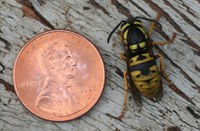Yellowjackets Becoming a Nuisance
(Click the image below to view a high-resolution image that can be downloaded)
Yellowjackets Becoming a Nuisance
Hornets are starting to annoy homeowners by swarming or building nests in homes or in trees near houses, according to Janet Knodel, North Dakota State University Extension Service entomologist.
Hornets (or yellowjackets) are wasps that belong to the Vespidae family.
“All yellowjackets sting, and their stinging behavior is considered a defensive reaction when the colony is threatened,” Knodel says. “They can sting more than once because their stinger stays with the insect.”
Yellowjackets are more aggressive during August and September and more likely to sting people. Although yellowjackets are a beneficial insect feeding on other insects, they often become a pest problem when their nests are near homes, schools, picnic areas or playgrounds. When that happens, pest control often is warranted.
Wasps are social insects and build nests of paperlike material. Nests generally are underground in mammal burrows, cavities or behind the siding of a house.
Vespid wasps are active outside the nest during the daylight hours. Nearly the entire colony is in the nest during the evening and nighttime hours, so control measures should be applied to the nest at that time. There are many insecticides labeled for control of hornets and yellowjackets.
“The difficulty is making the treatment without being stung,” Knodel says. “Usually an aerosol spray of one of the many fast-acting wasp killers will quickly kill all the workers present in a nest.”
Products that contain permethrin, synergized pyrethrins or pyrethroid insecticides such as esfenvalerate or lambda cyhalothrin will get rid of wasps.
A slower-acting insecticidal approach is to apply carbaryl (Sevin) dust directly onto the exposed nest and entrance hole. After treatment, check the nest for any activity the following day and do another treatment if necessary.
Nests should be removed to avoid attracting dermestid beetles later and keep wasp pupae from possibly re-establishing the nest.
“If you are dealing with yellowjacket nests in structures such as a home, the nest entrance should never be plugged from the outside,” Knodel says. “If constrained, yellowjacket workers cannot escape to the outside, so they may locate or chew a new way to escape toward the inside of the home or structure. This would create a possible stinging threat for people inside.”
When outside enjoying a picnic, avoid wearing bright colors and perfumes that are attractive to hornets and yellowjackets. Also, keep garbage away from the picnic table.
In northern temperate climates, only the mated queen wasp overwinters from the previous year’s colony. Queens are inactive during the winter and hide in protected places such as under tree bark or attics.
In early spring, the overwintering queen builds a new nest and lays an egg in each cell. Larvae hatch from the eggs and are dependent on the queen for food. The queen forages outside the nest and brings food (caterpillars and other insects) back to the larvae until pupation.
Sterile female workers emerge from the pupae and take over nest building and brood rearing, while the queen stays in the nest. During late summer into early fall, adult males and newly produced queens leave the parent colony. The colony dies off and only newly mated queens will find a protected place to overwinter.
NDSU Agriculture Communication – Aug. 17, 2012
| Source: | Janet Knodel, (701) 231-7915, janet.knodel@ndsu.edu |
|---|---|
| Editor: | Rich Mattern, (701) 231-6136, richard.mattern@ndsu.edu |


